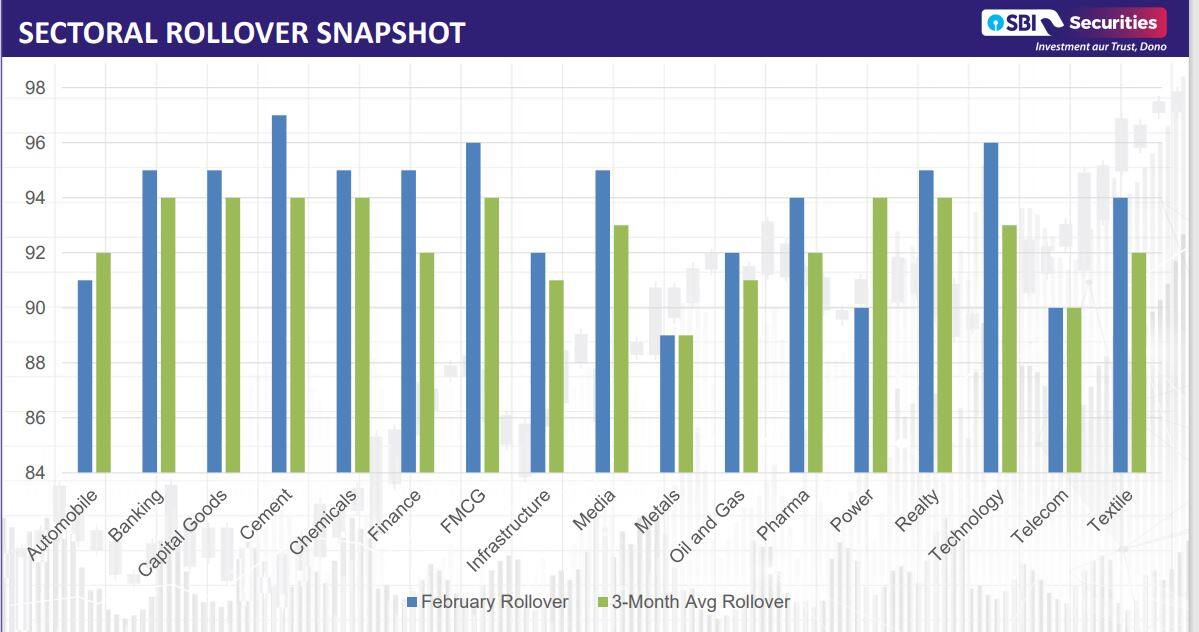What does rollover data say about position build-up in the March series


Market wide rollover stood at 92 percent compared to 91 percent (M-o-M).
Throughout the February series, the Nifty future navigated within a narrow range of 743 points, representing the tightest monthly range seen since August 2023. Despite the consolidation, Nifty ended the series at 21983 level with the gain of nearly 3 percent.
Notably, the Rollover for the Nifty Index futures stood at 79.31 percent, a decline from the previous month’s 81.28 percent and the three-month average of 80.04 percent. The number of shares rolled increased to 140 lakhs as compared to 128 lakh last month. Moreover, the rollover cost climbed to 0.92 percent, which is showing an uptick from the three-month average of 0.66.
Rise of market-wide rollover
Market-wide rollover stood at 92 compared to 91 percent (MoM).
FII positions
As per SBI Securities, in the latest series, the long-short ratio based on FII index positions has shown a notable decline, currently standing at 34.99 percent.
Nifty outlook
According to Sudeep Shah, DVP and Head of Derivative and Technical Research at SBI Securities, “For the next weekly series, notable call open interest is observed at the 22200 CE, followed by the 22300 strike. Meanwhile, on the put side, there is noteworthy open interest at 22000 PE, followed by the 21900 strike.”
Story continues below Advertisement
“This indicates the zone of 21850-21750 (Previous swing support, 50 DMA zone) will act as crucial support for the index. While, the zone of 22200-22250 will act as crucial resistance for the index. Above 22250, Fresh Momentum up to 22500-22650 could be witnessed. While, on the downside, if the index breaks the level of 21750, acceleration of profit booking up to 21400-21300 could be witnessed,” added Shah.
Bank Nifty outlook
Despite ending the series with a 2.77 percent gain, Bank Nifty futures sustained its underperformance throughout the February series. Rollover for Bank Nifty futures stood at 74.24 percent, trailing behind the previous month’s figure of 77.05 percent and the three-month average of 77.36 percent. Moreover, the rollover cost increased to 0.99 percent, marking a rise compared to the three-month average of 0.75 percent.
“The trend of Bank Nifty in the month of March has been mixed over the last 16 years. On 8 occasions, the index concluded positively with an average gain of 11.55 percent, while on 8 occasions, it ended negatively with an average loss of 9.87 percent. Over the last 16 years, the average return for Bank Nifty in March stood at 0.84. Over the past 10 years, the average volatility during the March series was 10.46 percent for Bank Nifty, considering the Covid-induced fall,” said Shah.
Going ahead, Shah highlights that the zone of 45600-45500 will act as crucial support for the index. “Any sustainable move below the level of 45500 will lead to further selling pressure in the index up to the level of 44800 in the short term. While, on the upside, the 50 DMA zone of 46700-46800 will act as crucial resistance for the index. If the index sustains above 46800, then we may see a sharp upside rally up to the level of 47400, followed by 48000 in the short term.”
Market breadth of Single Stock Futures
123 stocks, comprising approximately 66 percent of derivative space stocks, concluded on a positive note. Conversely, 63 stocks, representing 34 percent, closed negatively. This suggests that despite the index trading within a narrow range, there was notable stock-specific action in the market.

Potential Outperforming Sectors based on Roll-Over Data: Pharma, Auto, Capital Good, Consumer Durable, Realty, Oil & Gas, Cement, Telecom and IT.
Potential Underperforming Sectors based on Roll-Over Data: Media, Financial Services, FMCG and Metal.
Disclaimer: The views and investment tips expressed by investment experts on Moneycontrol.com are their own and not those of the website or its management. Moneycontrol.com advises users to check with certified experts before taking any investment decisions.









